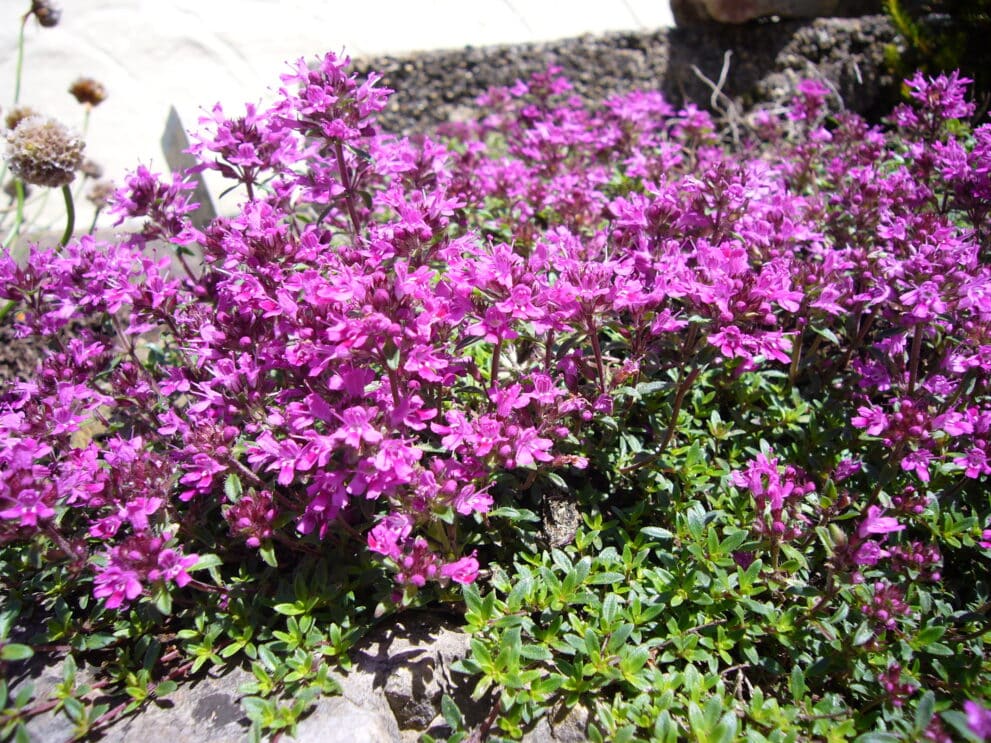
What is Red Creeping thyme?
Red creeping thyme (Thymus praecox ‘Coccineus’) is a low-growing, spreading herb that is commonly used as a ground cover in gardens and landscapes. It is a type of thyme that is native to southern Europe and western Asia, but is now widely cultivated in North America and other parts of the world.
Red creeping thyme is known for its attractive foliage, which is a deep green color that turns bronze in the fall. The leaves are small, oval-shaped, and emit a pleasant fragrance when crushed. In the summer, the plant produces clusters of tiny pink to purple flowers that add color to the garden.
One of the benefits of red creeping thyme is that it is low maintenance and can tolerate a range of growing conditions. It prefers well-drained soil and full sun, but can also grow in partial shade. It is drought tolerant and can handle some foot traffic, making it a great choice for use as a ground cover between pavers or in areas where grass is difficult to grow.
In addition to its ornamental value, red creeping thyme has culinary uses and is often used to flavor meats, soups, and stews. It is also believed to have medicinal properties and has been used to treat coughs, bronchitis, and other respiratory ailments.
How do you plant red creeping thyme?
Red creeping thyme is relatively easy to plant and care for. Here are the general steps to follow when planting red creeping thyme:
- Choose a suitable location: Red creeping thyme prefers well-drained soil and full sun, but can also tolerate partial shade. Make sure the area you choose receives at least 6 hours of sunlight each day.
- Prepare the soil: If the soil is heavy or has poor drainage, add some sand or gravel to improve drainage. Work some compost or other organic matter into the soil to improve its fertility and structure.
- Plant the thyme: Dig small holes in the soil that are slightly wider than the root ball of the plant. Space the plants about 12-18 inches apart. Gently place the plants in the holes and backfill with soil. Water the plants well after planting.
- Mulch around the plants: Adding a layer of mulch around the plants can help to retain moisture in the soil and suppress weeds.
- Water the plants: Water the plants regularly, especially during hot, dry weather. Avoid overwatering, as this can lead to root rot.
- Fertilize the plants: Red creeping thyme doesn’t require a lot of fertilizer, but you can apply a slow-release fertilizer once or twice a year to promote healthy growth.
- Prune the plants: Prune the plants back in the spring or early summer to promote bushy growth and remove any dead or damaged foliage.
With proper care, red creeping thyme can grow into a lush, attractive ground cover that adds color and texture to your garden.
Is Red Creeping Thyme invasive?
Red creeping thyme (Thymus serpyllum coccineus) is generally not considered an invasive plant, but it can be aggressive in certain growing conditions. It is a low-growing, spreading plant that can be used as a ground cover, and it is often planted in rock gardens, along borders, and in between stepping stones. While it is not usually invasive, it is important to monitor its growth and prune it back if it starts to spread beyond its intended area. It is always a good idea to check with your local gardening or environmental authorities to determine if any plants are considered invasive in your particular region.
Can red creeping thyme grow in Canada?
Can you eat red creeping thyme?
Is the proper name red creeping thyme or creeping red thyme?
Can you plant red creeping thyme on your lawn?
Where can you buy red creeping thyme seeds in Canada?
- West Coast Seeds: This is a Canadian seed company that offers organic and non-GMO seeds for vegetables, flowers, and herbs, including red creeping thyme. You can order seeds online or find a local retailer near you.
- Veseys Seeds: This is another Canadian seed company that sells seeds for various plants, including red creeping thyme. You can order seeds online or request a catalog to be mailed to you.
- Richters Herbs: This is a Canadian herb and plant nursery that offers a wide range of herb seeds and plants, including red creeping thyme. You can order seeds online or visit their nursery in Ontario.
- Amazon.ca: You can also find red creeping thyme seeds on Amazon.ca, which offers a range of options from different sellers. However, be sure to check the seller’s reputation and reviews before making a purchase.
It’s always a good idea to compare prices and shipping fees before making a purchase to ensure that you are getting the best deal. Additionally, you may want to check with your local garden center or nursery to see if they carry red creeping thyme seeds or plants.



 Share
Share Tweet
Tweet Share
Share




Comment